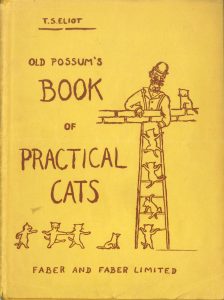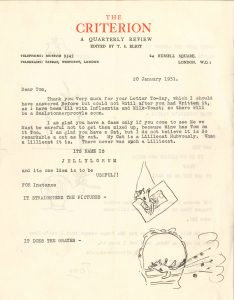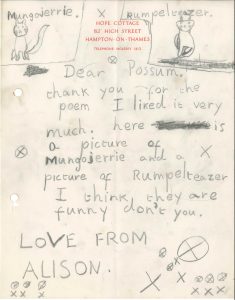
This Christmas sees the 80th anniversary of the first broadcast of a selection of T. S. Eliot’s Practical Cats poems. The poems, which weren’t published until almost two years later, were read by Eliot’s friend, Geoffrey Tandy – a writer, broadcaster and scientist who worked at the Natural History Museum. Tandy wrote the Broadcasting Chronicle for the Criterion and he and Eliot became good friends, as did the whole Tandy family – Geoffrey’s wife Doris ‘Polly’ Tandy and their three children, Alison, Richard, and Anthea to whom Eliot was godfather.
Eliot began writing cat poems in the 1930s, testing them out on his godchildren and the Tandy family. The first cat character appears to have been ‘Jellylorum’ who Eliot introduced to his godson, Tom Faber, in a letter on 20th January 1931. ‘I am glad you have a cat’, Eliot wrote, ‘but I do not believe it is So remarkable a cat as My cat. My Cat is a Lilliecat Hubvously. What a Lilliecat it is.’

Eliot sent a number of draft cat poems to Alison Tandy, including ‘The Old Gumbie Cat’, ‘The Rum Tum Tugger’ and a poem about two new cats which he introduced in a letter on the 21st October 1937: ‘Some time ago I mentioned in a letter that I was meaning to write a Poem about TWO Cats, named Mungojerrie and Rumpelteazer – and here it is. You may not like it, because those two cats have turned out to be even Worse that I expected.’
Alison liked the poem and replied with a delightful letter to ‘Possum’, illustrated with drawings of Mungojerrie and Rumpelteazer.

In November 1937 Eliot met with Geoffrey Tandy and Ian Cox of the Programme Division at the BBC to discuss the possibility of a broadcast reading of Eliot’s unpublished poems about cats and dogs; too busy to prepare anything himself, Eliot agreed to Tandy and Cox making a programme to be broadcast on Christmas Day. After gathering all of the poems, they found enough material for two programmes and decided it would be best to confine the Christmas programme to cats. Eliot agreed suggesting that the programme be headed ‘Practical Cats’, though he was cautious about planning a second programme: ‘I think it would be best to wait until you find out how that programme is received before fixing any further reading’.
Announcing the broadcast on 17 December, The Radio Times wrote: ‘For some time past Mr Eliot has been amusing and instructing the offspring of some of his friends in verse on the subject of cats. These poems are not the kind that have been usually associated with his name, and they have not yet been published.’
On Christmas Day afternoon Geoffrey Tandy read five Practical Cats poems on BBC ‘Regional’ radio. Eliot needn’t have worried about how the poems would be received – the broadcast was a great success with the BBC repeating it several times in 1938. A second programme, Cats Mostly Practical, was broadcast on 25th June 1938 and a third, Pollicles and Jellicles: Tales of Cats and Dogs in Verse followed on 7th October 1939. Announcing the third programme, the Radio Times wrote, ‘Before Christmas Day 1937, when the first selection was broadcast, nobody would have associated a set of cheery, yet at the same time profound, verses on the subjects of dogs and cats with the name of T. S. Eliot. Nevertheless the author of The Waste Land has written such verses, originally for the amusement of his friends’ children.’
A selection of T. S. Eliot’s letters to the Tandy family held by the British Library can be seen online here


